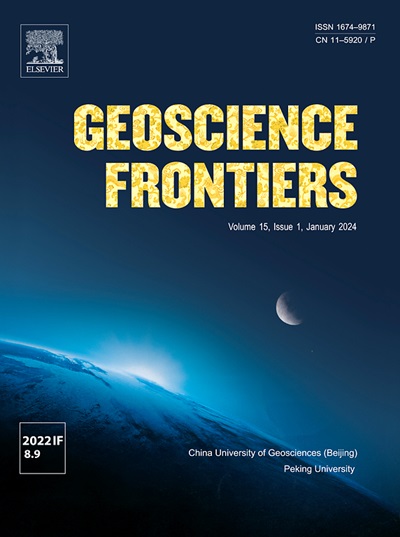A critical review of hurricane risk assessment models and predictive frameworks
IF 8.9
1区 地球科学
Q1 GEOSCIENCES, MULTIDISCIPLINARY
引用次数: 0
Abstract
Hurricanes are one of the most destructive natural disasters that can cause catastrophic losses to both communities and infrastructure. Assessment of hurricane risk furnishes a spatial depiction of the interplay among hazard, vulnerability, exposure, and mitigation capacity, crucial for understanding and managing the risks hurricanes pose to communities. These assessments aid in gauging the efficacy of existing hurricane mitigation strategies and gauging their resilience across diverse climate change scenarios. A systematic review was conducted, encompassing 94 articles, to scrutinize the structure, data inputs, assumptions, methodologies, perils modelled, and key predictors of hurricane risk. This review identified key research gaps essential for enhancing future risk assessments. The complex interaction between hurricane perils may be disastrous and underestimated in the majority of risk assessments which focus on a single peril, commonly storm surge and flood, resulting in inadequacies in disaster resilience planning. Most risk assessments were based on hurricane frequency rather than hurricane damage, which is more insightful for policymakers. Furthermore, considering secondary indirect impacts stemming from hurricanes, including real estate market and business interruption, could enrich economic impact assessments. Hurricane mitigation measures were the most under-utilised category of predictors leveraged in only 5% of studies. The top six predictive factors for hurricane risk were land use, slope, precipitation, elevation, population density, and soil texture/drainage. Another notable research gap identified was the potential of machine learning techniques in risk assessments, offering advantages over traditional MCDM and numerical models due to their ability to capture complex nonlinear relationships and adaptability to different study regions. Existing machine learning based risk assessments leverage random forest models (42% of studies) followed by neural network models (19% of studies), with further research required to investigate diverse machine learning algorithms such as ensemble models. A further research gap is model validation, in particular assessing transferability to a new study region. Additionally, harnessing simulated data and refining projections related to demographic and built environment dynamics can bolster the sophistication of climate change scenario assessments. By addressing these research gaps, hurricane risk assessments can furnish invaluable insights for national policymakers, facilitating the development of robust hurricane mitigation strategies and the construction of hurricane-resilient communities. To the authors’ knowledge, this represents the first literature review specifically dedicated to quantitative hurricane risk assessments, encompassing a comparison of Multi-criteria Decision Making (MCDM), numerical models, and machine learning models. Ultimately, advancements in hurricane risk assessments and modelling stand poised to mitigate potential losses to communities and infrastructure both in the immediate and long-term future.

飓风风险评估模式和预测框架的批判性审查
飓风是最具破坏性的自然灾害之一,可能给社区和基础设施造成灾难性损失。飓风风险评估提供了灾害、脆弱性、暴露和减灾能力之间相互作用的空间描述,这对于了解和管理飓风对社区构成的风险至关重要。这些评估有助于衡量现有飓风缓解战略的效力,并衡量它们在不同气候变化情景下的复原力。进行了系统的审查,包括94篇文章,仔细审查了飓风风险的结构、数据输入、假设、方法、风险建模和关键预测因素。这一综述确定了对加强未来风险评估至关重要的关键研究差距。飓风灾害之间复杂的相互作用可能是灾难性的,而且在大多数风险评估中被低估了,这些评估主要关注单一的灾害,通常是风暴潮和洪水,导致灾害恢复规划的不足。大多数风险评估都是基于飓风的频率,而不是飓风的破坏程度,这对决策者来说更有洞察力。此外,考虑飓风造成的次级间接影响,包括房地产市场和商业中断,可以丰富经济影响评估。在只有5%的研究中,飓风缓解措施是最未得到充分利用的预测指标类别。飓风风险的前六个预测因素是土地利用、坡度、降水、海拔、人口密度和土壤质地/排水。另一个值得注意的研究差距是机器学习技术在风险评估中的潜力,由于能够捕捉复杂的非线性关系和对不同研究区域的适应性,机器学习技术比传统的MCDM和数值模型具有优势。现有的基于机器学习的风险评估利用随机森林模型(42%的研究),其次是神经网络模型(19%的研究),需要进一步研究各种机器学习算法,如集成模型。进一步的研究缺口是模型验证,特别是评估可转移性到一个新的研究区域。此外,利用模拟数据和改进与人口和建筑环境动态相关的预测可以提高气候变化情景评估的复杂性。通过解决这些研究差距,飓风风险评估可以为国家决策者提供宝贵的见解,促进制定强有力的飓风缓解战略和建设具有飓风复原力的社区。据作者所知,这是第一次专门针对定量飓风风险评估的文献综述,包括多标准决策(MCDM)、数值模型和机器学习模型的比较。最终,飓风风险评估和建模方面的进步将在近期和长期内减轻对社区和基础设施的潜在损失。
本文章由计算机程序翻译,如有差异,请以英文原文为准。
求助全文
约1分钟内获得全文
求助全文
来源期刊

Geoscience frontiers
Earth and Planetary Sciences-General Earth and Planetary Sciences
CiteScore
17.80
自引率
3.40%
发文量
147
审稿时长
35 days
期刊介绍:
Geoscience Frontiers (GSF) is the Journal of China University of Geosciences (Beijing) and Peking University. It publishes peer-reviewed research articles and reviews in interdisciplinary fields of Earth and Planetary Sciences. GSF covers various research areas including petrology and geochemistry, lithospheric architecture and mantle dynamics, global tectonics, economic geology and fuel exploration, geophysics, stratigraphy and paleontology, environmental and engineering geology, astrogeology, and the nexus of resources-energy-emissions-climate under Sustainable Development Goals. The journal aims to bridge innovative, provocative, and challenging concepts and models in these fields, providing insights on correlations and evolution.
 求助内容:
求助内容: 应助结果提醒方式:
应助结果提醒方式:


